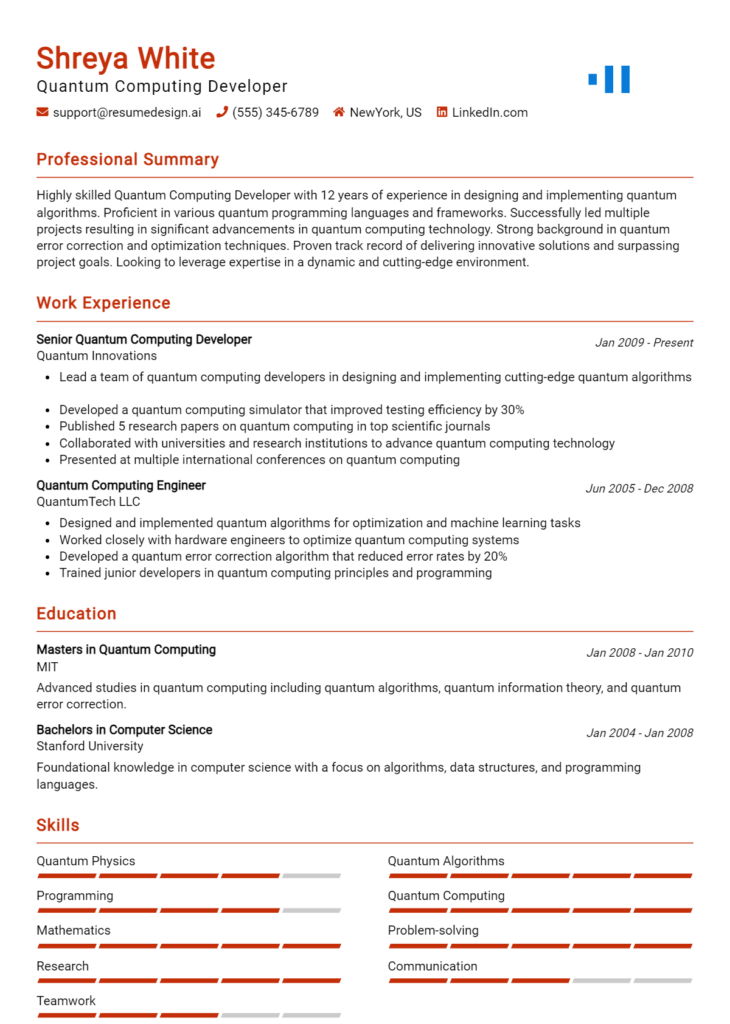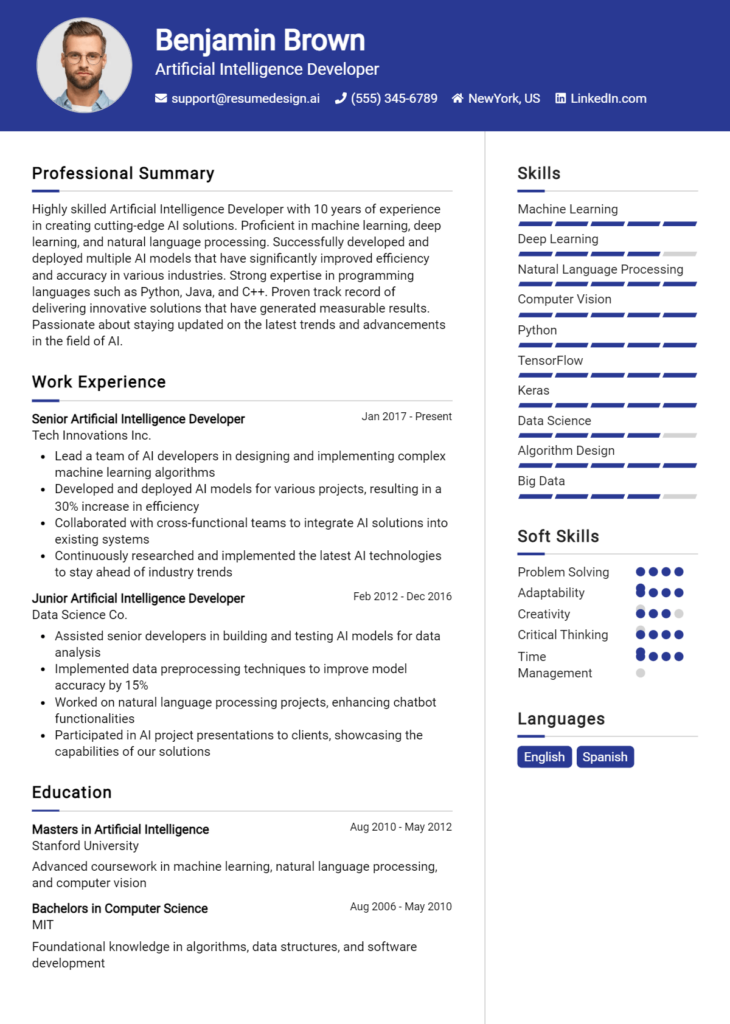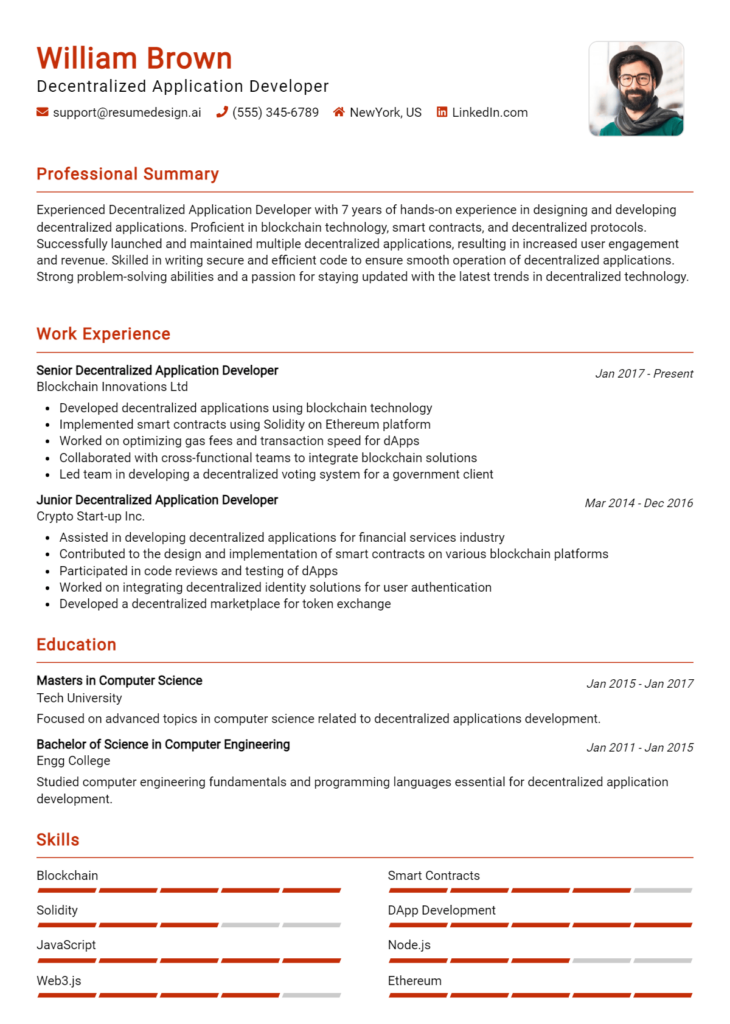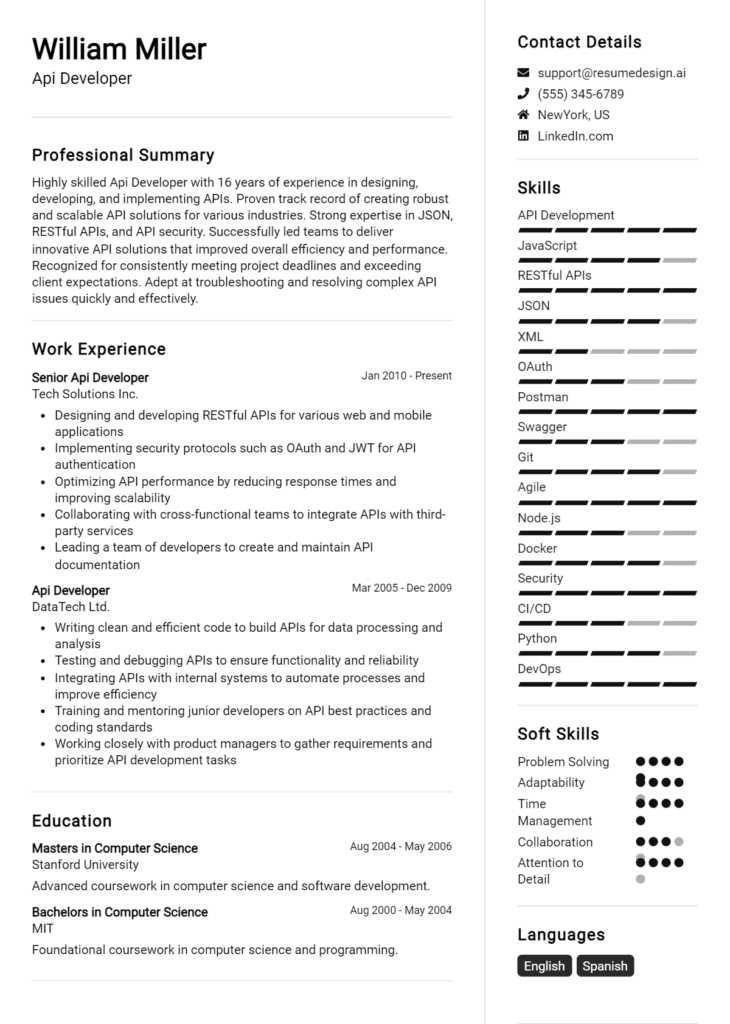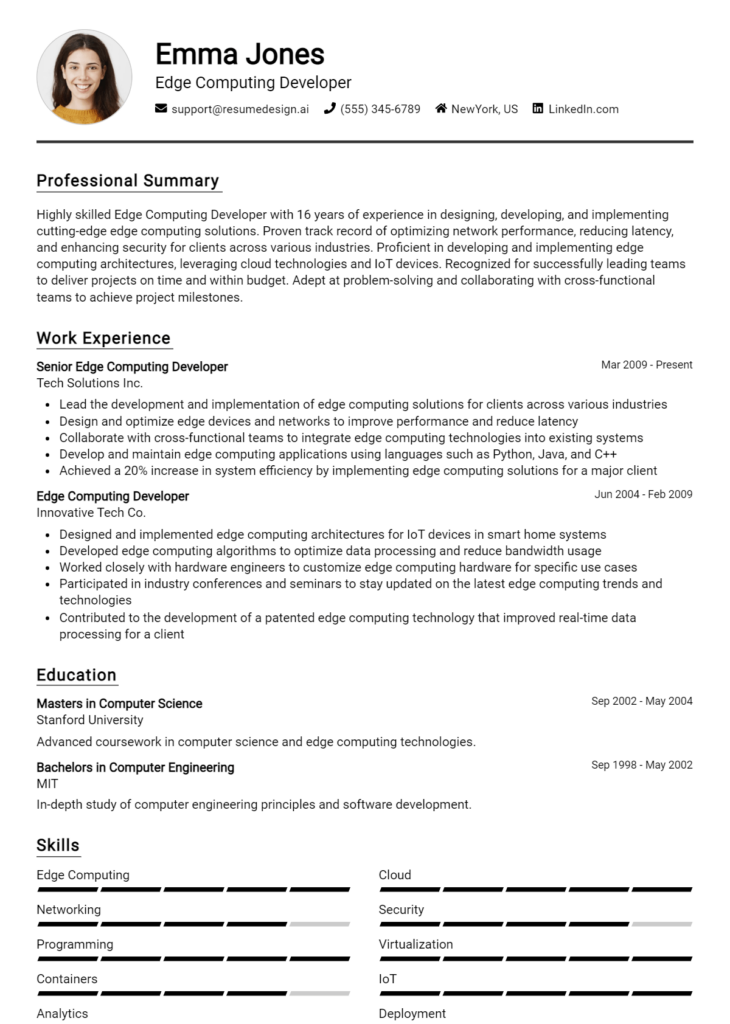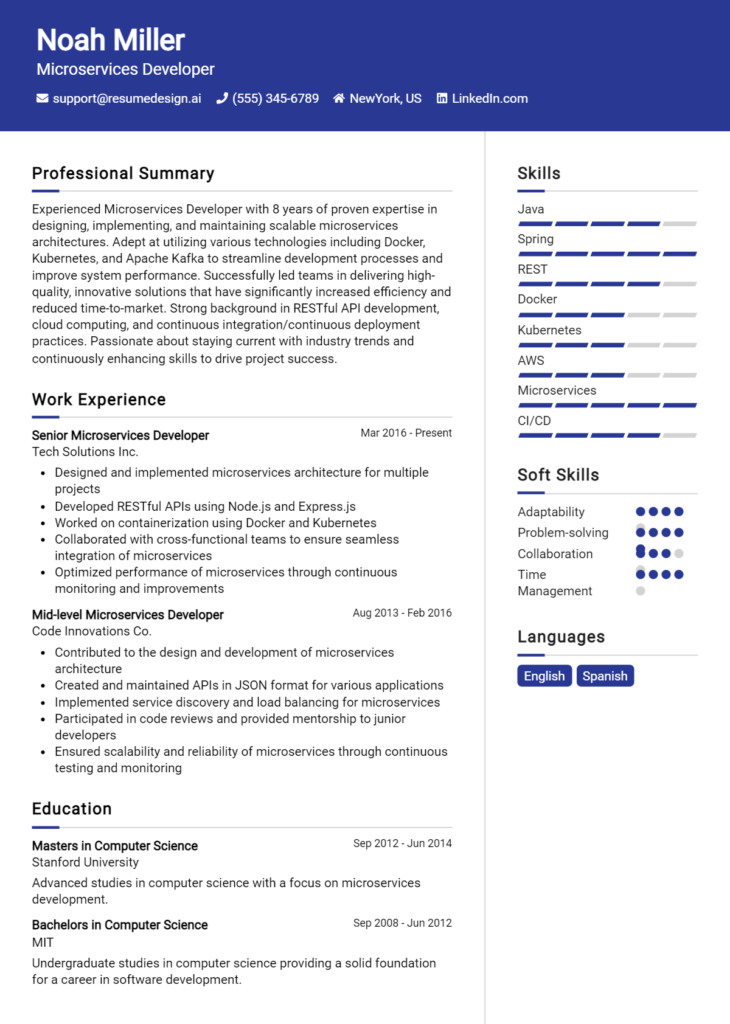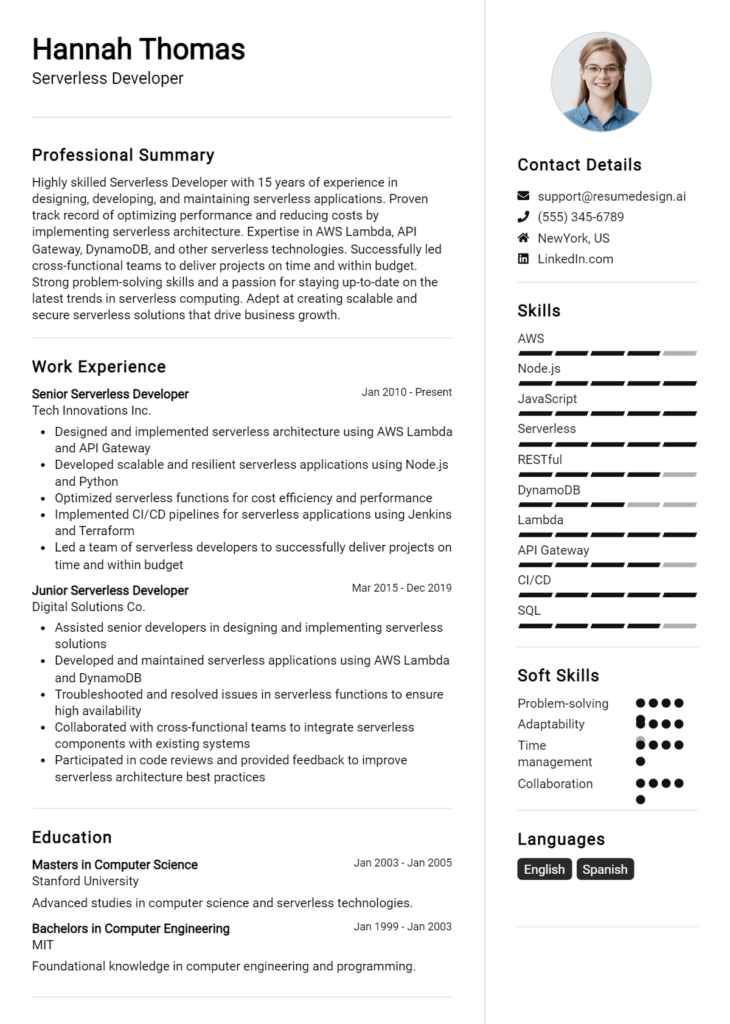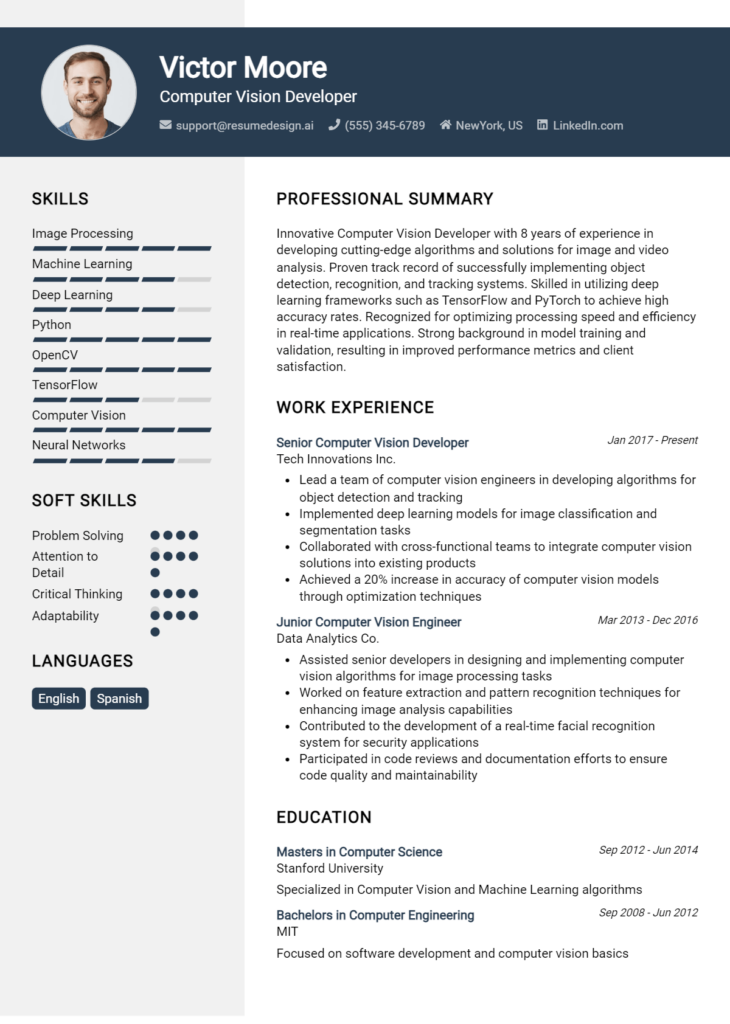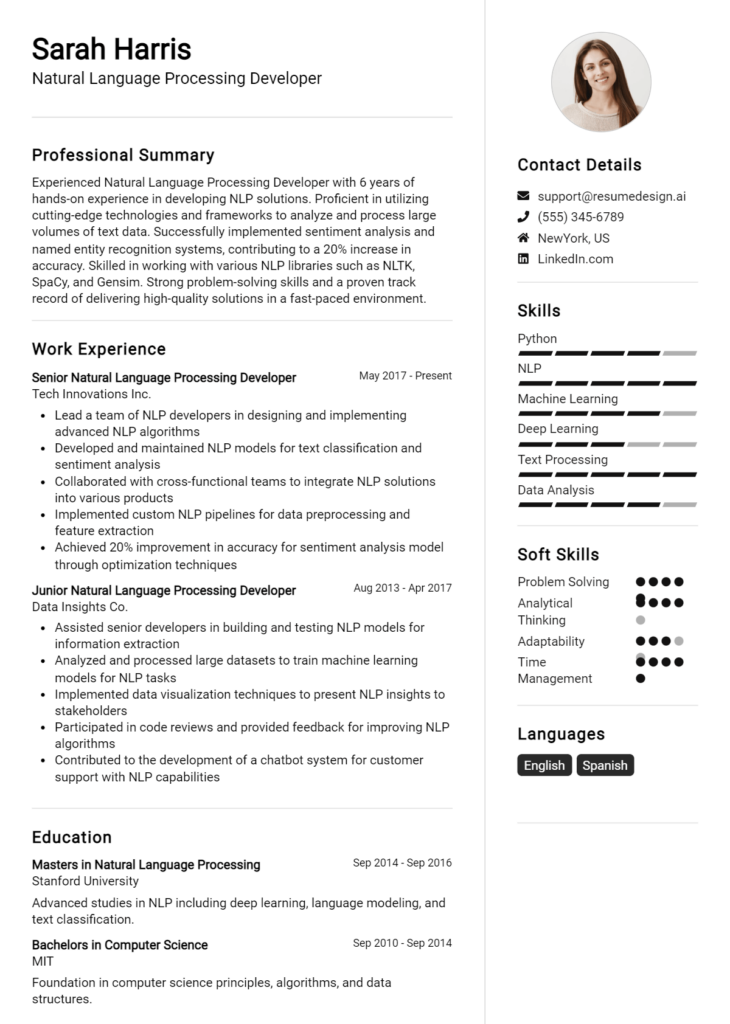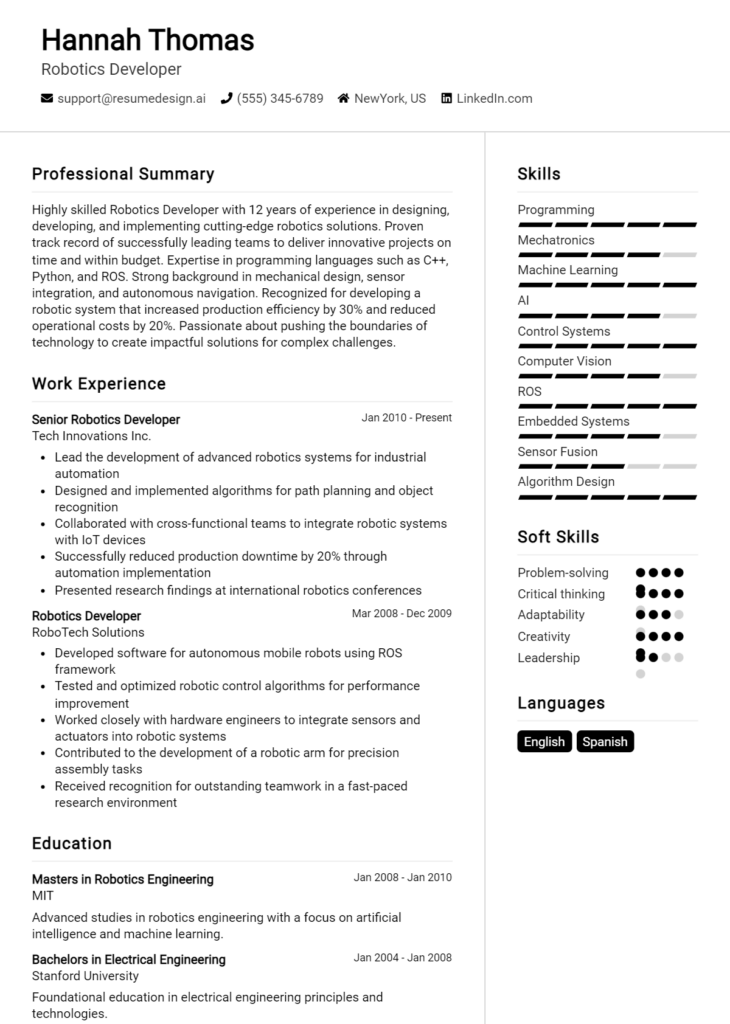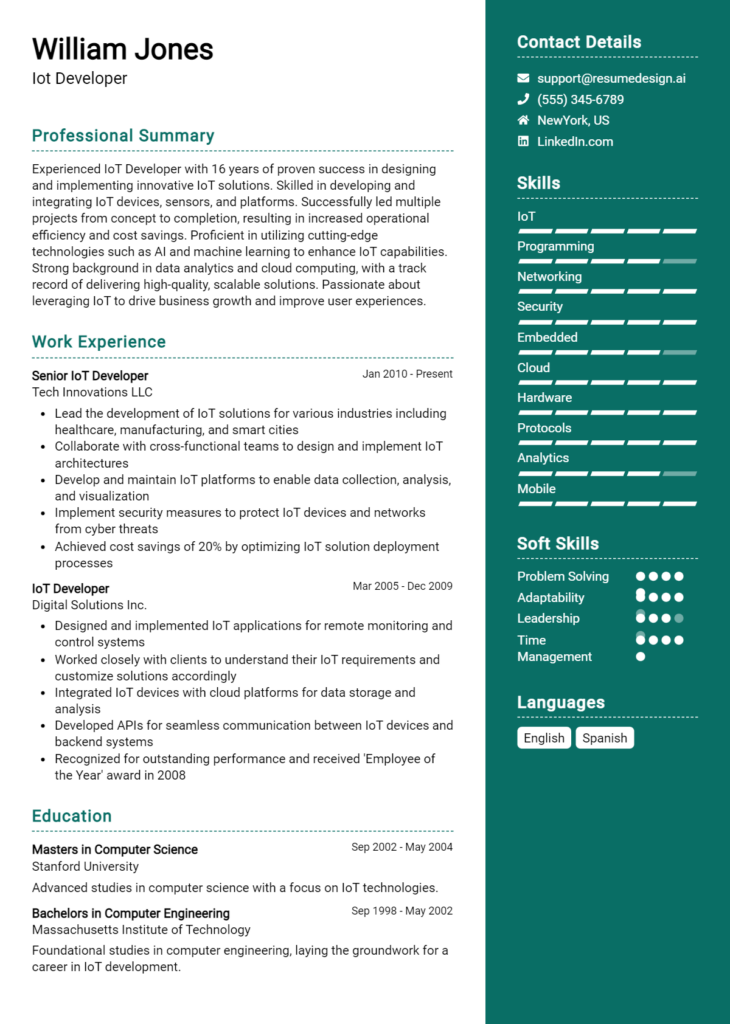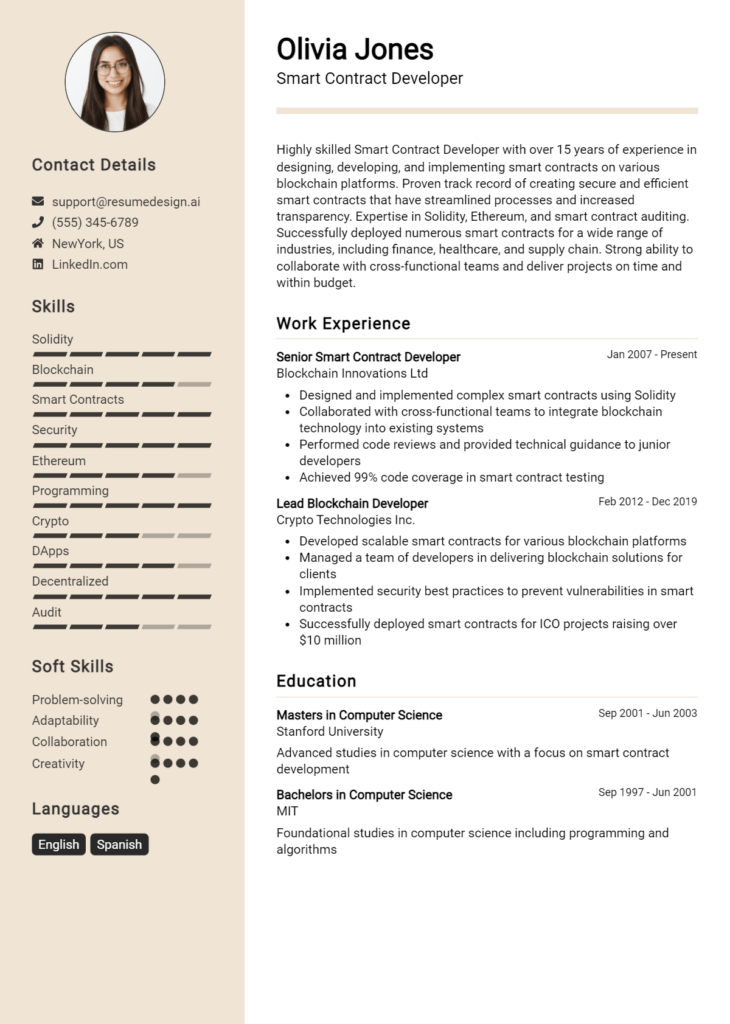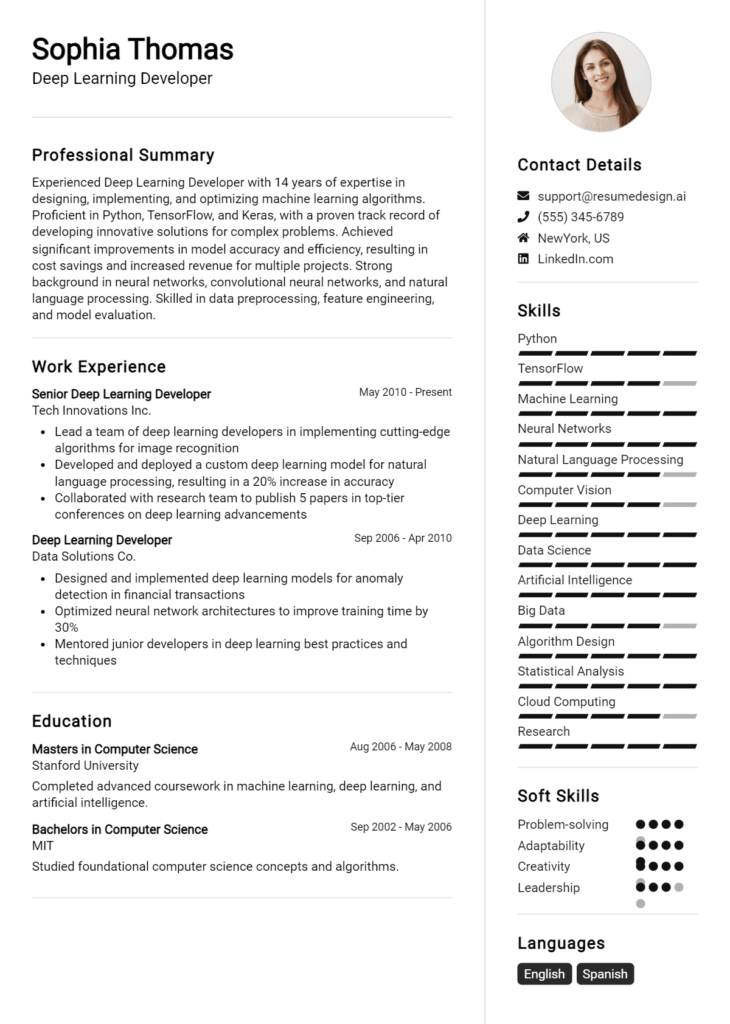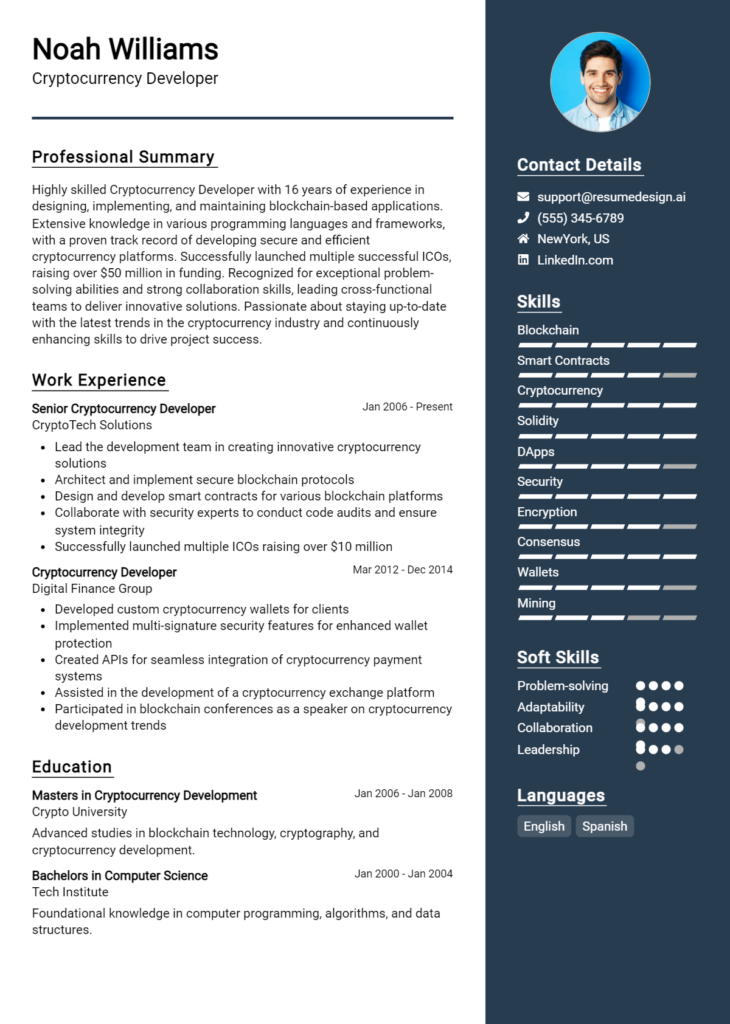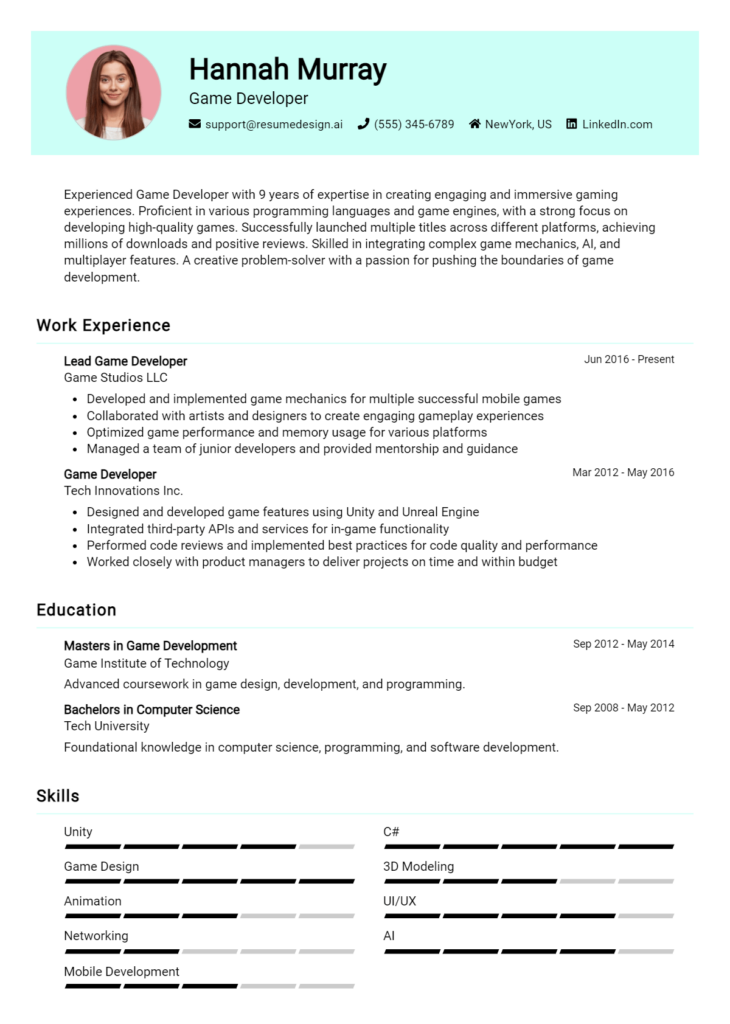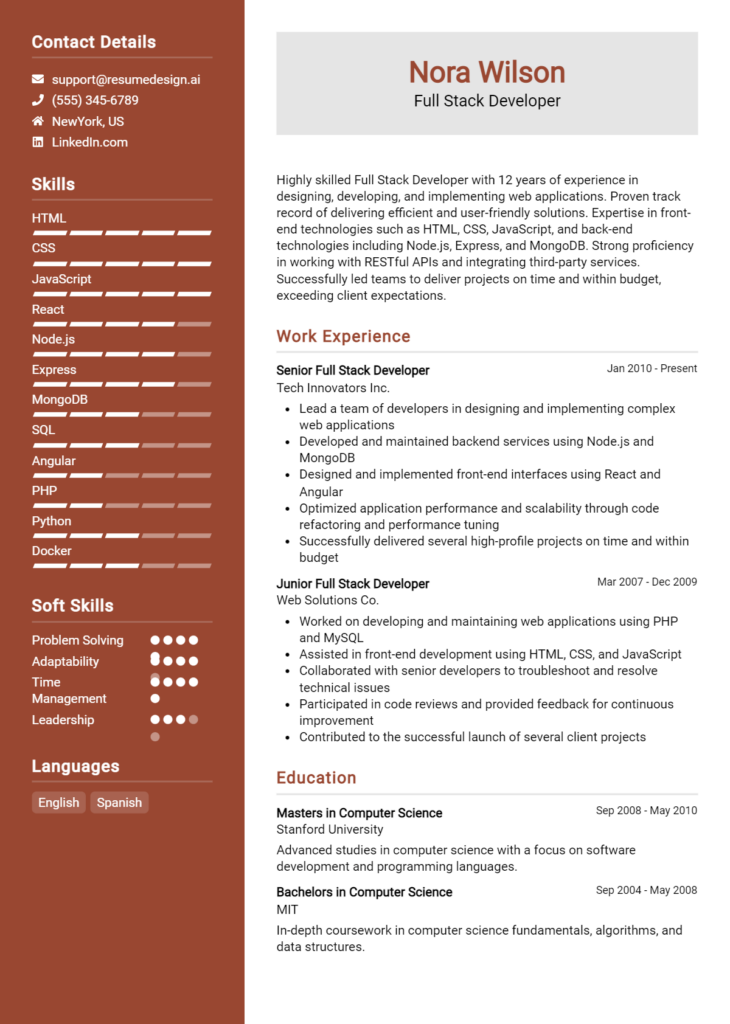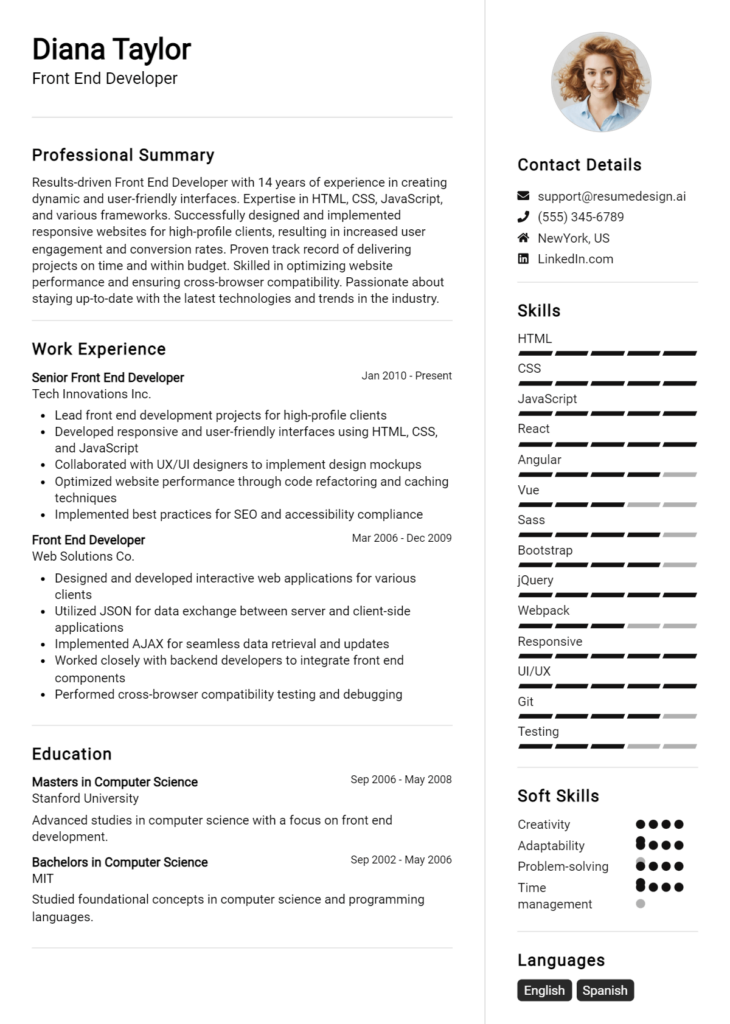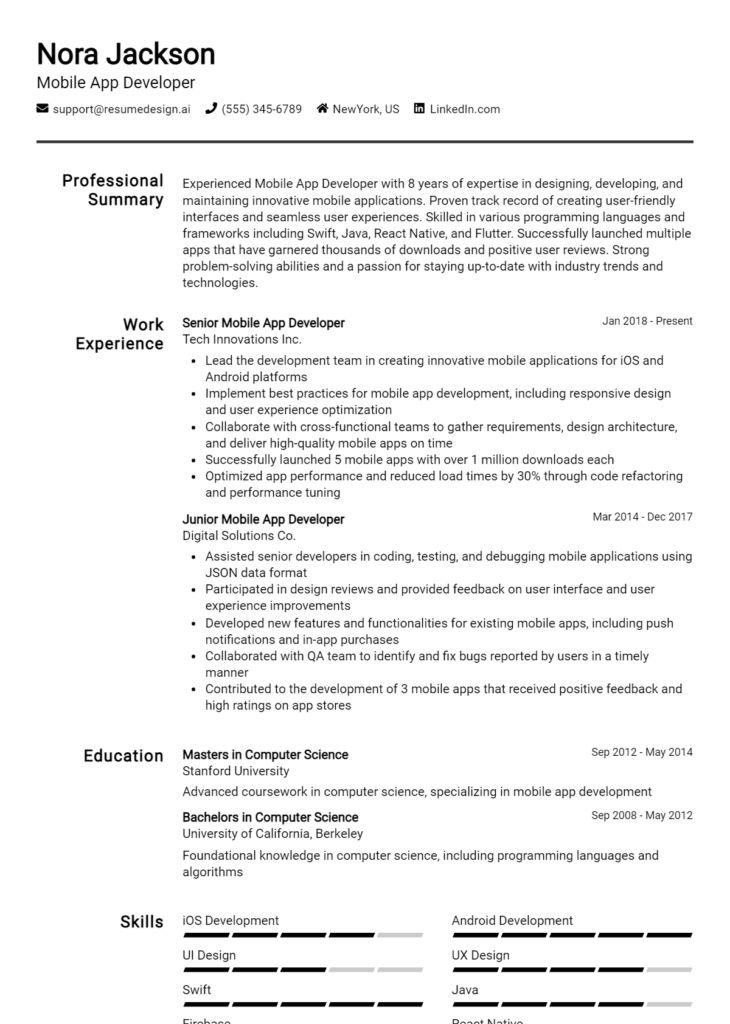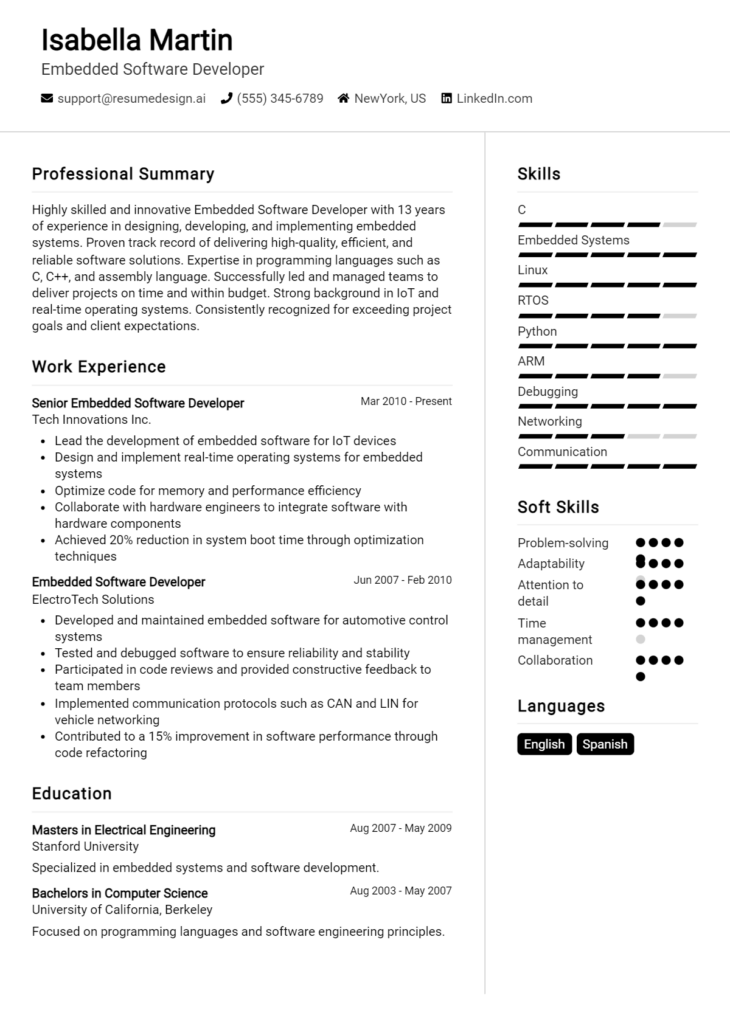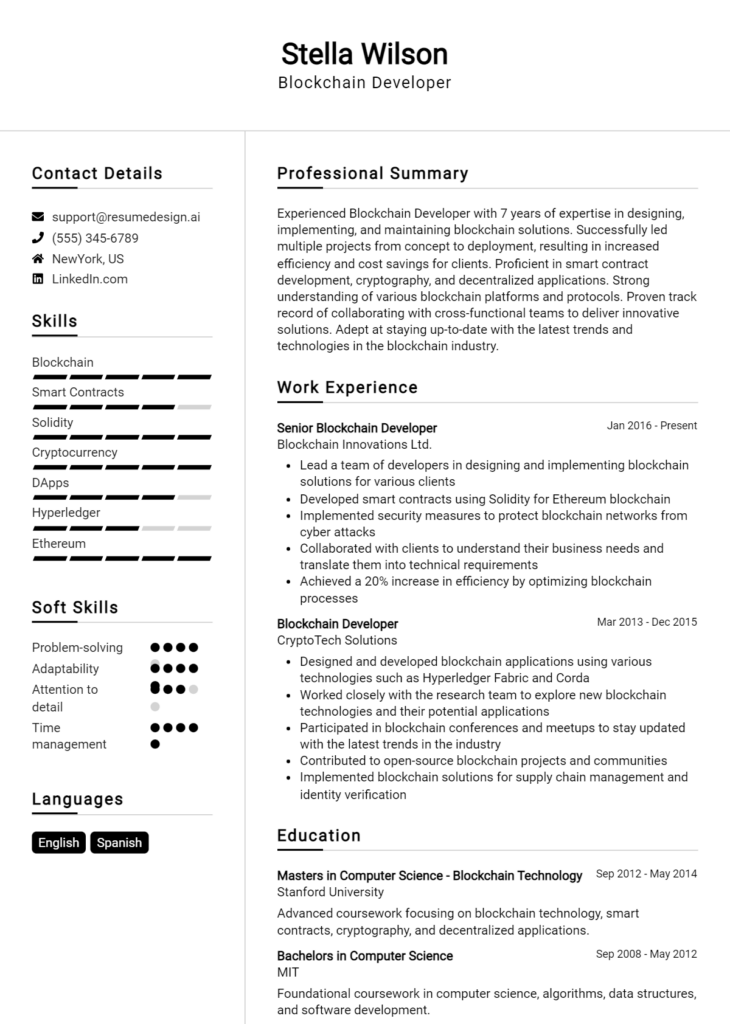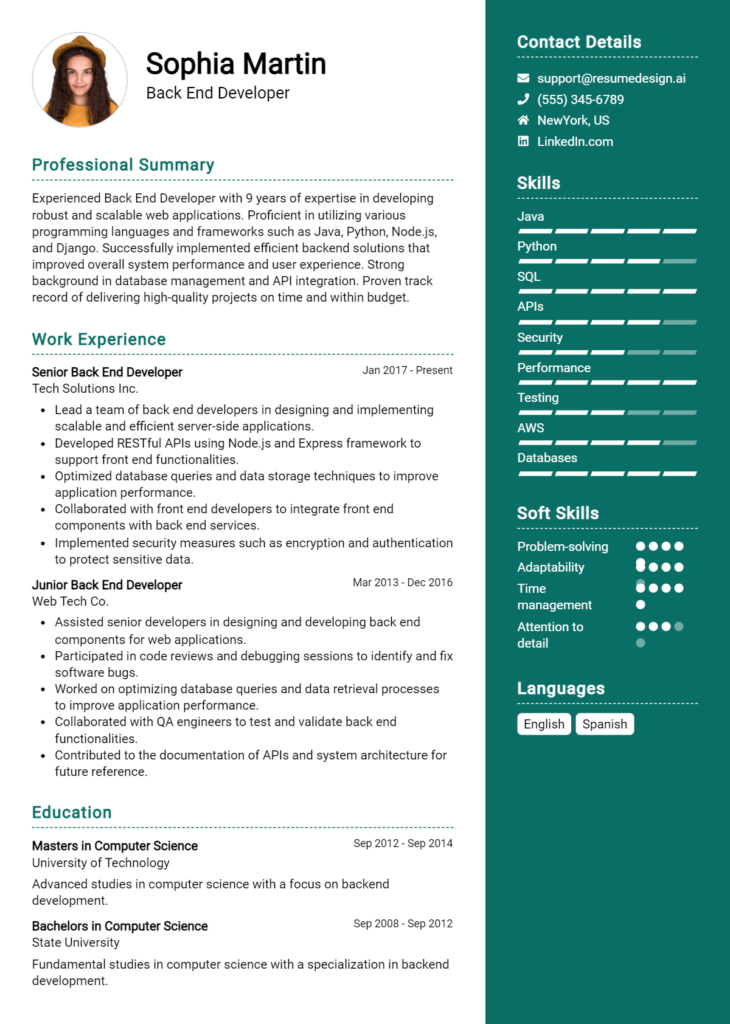Firmware Developer Core Responsibilities
A Firmware Developer is responsible for designing, coding, testing, and debugging firmware for embedded systems, playing a crucial role in bridging engineering, hardware, and software teams. Essential skills include proficiency in programming languages such as C/C++, strong problem-solving capabilities, and a solid understanding of hardware interfaces. These abilities help optimize performance and ensure reliability, directly contributing to the organization’s goals. A well-structured resume highlighting these qualifications can effectively demonstrate a candidate's value to potential employers.
Common Responsibilities Listed on Firmware Developer Resume
- Design and implement firmware for embedded systems.
- Collaborate with hardware engineers to define system requirements.
- Conduct thorough testing and debugging of firmware.
- Write and maintain technical documentation for firmware processes.
- Optimize firmware performance for real-time applications.
- Develop and execute test plans to ensure software quality.
- Participate in code reviews and provide constructive feedback.
- Stay updated with industry trends and emerging technologies.
- Support the integration of firmware with hardware components.
- Troubleshoot and resolve firmware-related issues in production.
- Collaborate with cross-functional teams to meet project deadlines.
- Implement best practices for firmware development and version control.
High-Level Resume Tips for Firmware Developer Professionals
In the competitive field of firmware development, a well-crafted resume is essential for making a strong first impression on potential employers. Your resume serves as the gateway to showcasing your technical prowess, problem-solving abilities, and relevant achievements. It is crucial that it not only highlights your skills but also presents your accomplishments in a way that resonates with hiring managers. This guide will provide practical and actionable resume tips specifically tailored for Firmware Developer professionals, ensuring that your resume stands out in a crowded job market.
Top Resume Tips for Firmware Developer Professionals
- Tailor your resume to the job description by incorporating relevant keywords and phrases that match the specific requirements of the position.
- Showcase your relevant experience by listing projects and roles that directly relate to firmware development, including internships and personal projects.
- Quantify your achievements with metrics, such as reduced load times, improved performance percentages, or successful project completions within deadlines.
- Highlight industry-specific skills, such as proficiency in programming languages like C, C++, or Python, and experience with hardware interfaces and embedded systems.
- Include certifications or relevant educational background, emphasizing any specialized training in firmware development or related fields.
- Utilize a clean and professional format that enhances readability, using clear headings and bullet points to break up sections of text.
- Demonstrate your problem-solving abilities by providing examples of challenges you've overcome in your previous roles or projects.
- Keep your resume concise, ideally one page, focusing on the most relevant information to capture the attention of hiring managers quickly.
- Incorporate a summary statement at the beginning of your resume that succinctly outlines your professional background and key strengths in firmware development.
By implementing these tips, you can significantly increase your chances of landing a job in the Firmware Developer field. A well-structured resume that effectively communicates your skills and achievements will not only capture the attention of hiring managers but also position you as a strong contender for the roles you aspire to. Take the time to refine your resume, and watch as it opens doors to exciting new opportunities in firmware development.
Why Resume Headlines & Titles are Important for Firmware Developer
In the competitive landscape of firmware development, a well-crafted resume headline or title is crucial for standing out among a sea of applicants. A strong headline acts as a concise summary of a candidate's key qualifications, immediately grabbing the attention of hiring managers and succinctly conveying their expertise. It should encapsulate the essence of the applicant's skills and experiences in a relevant manner that aligns with the job being applied for. By providing a clear and impactful statement, the headline sets the tone for the entire resume, enticing recruiters to delve deeper into the candidate’s qualifications.
Best Practices for Crafting Resume Headlines for Firmware Developer
- Keep it concise: Aim for a headline that is brief yet informative, ideally no more than 10-15 words.
- Be role-specific: Tailor the headline to reflect the specific position you are applying for, using relevant keywords.
- Highlight key strengths: Focus on your most impressive skills, experiences, or accomplishments that align with the job description.
- Avoid jargon: Use clear language that can be easily understood by hiring managers, avoiding overly technical terms unless necessary.
- Use action words: Start with strong verbs that convey your capabilities and achievements effectively.
- Include relevant certifications: If applicable, mention any key certifications that enhance your qualifications for the role.
- Reflect your unique selling point: Identify what sets you apart from other candidates and incorporate that into your headline.
- Review for clarity: Ensure that your headline is free from grammar or spelling errors, as these can detract from your professionalism.
Example Resume Headlines for Firmware Developer
Strong Resume Headlines
"Experienced Firmware Developer Specializing in Embedded Systems and IoT Solutions"
“Innovative Firmware Engineer with 5+ Years in Real-Time Operating Systems Development”
“Results-Driven Firmware Developer with a Proven Track Record in Agile Environments”
Weak Resume Headlines
“Looking for a Job in Technology”
“Firmware Developer”
The strong headlines are effective because they provide specific information about the candidate's expertise, years of experience, and areas of specialization, making it easy for hiring managers to see their fit for the role at a glance. In contrast, the weak headlines fail to impress due to their vagueness and lack of detail; they do not communicate any unique qualifications or strengths, leaving recruiters with little reason to continue reading. A compelling headline serves as a powerful tool in making a memorable first impression, ultimately enhancing the candidate's chances of securing an interview.
Writing an Exceptional Firmware Developer Resume Summary
A well-crafted resume summary is crucial for a Firmware Developer as it serves as the first impression of your qualifications to hiring managers. A strong summary succinctly encapsulates your most relevant skills, experience, and accomplishments, allowing you to quickly capture the attention of employers in a competitive job market. By highlighting your technical expertise and specific achievements, you can effectively convey your suitability for the position, making it essential to keep the summary concise, impactful, and tailored to the specific job you are applying for.
Best Practices for Writing a Firmware Developer Resume Summary
- Quantify achievements where possible to demonstrate impact, such as improving system efficiency by a percentage or reducing development time.
- Focus on key technical skills relevant to firmware development, such as proficiency in C/C++, embedded systems, and debugging tools.
- Tailor your summary to the job description, incorporating keywords that align with the specific requirements of the role.
- Highlight relevant certifications or training that enhance your qualifications, such as Certified Embedded Systems Engineer.
- Emphasize soft skills that complement technical abilities, such as problem-solving, teamwork, or communication skills.
- Keep it concise, ideally between 3 to 5 sentences, to maintain the reader's attention and convey your message effectively.
- Use action verbs to convey a sense of proactivity and responsibility in your past roles.
- Avoid jargon or overly technical language that may not resonate with all hiring managers; clarity is key.
Example Firmware Developer Resume Summaries
Strong Resume Summaries
Dynamic Firmware Developer with over 6 years of experience in designing and implementing embedded systems for IoT devices, achieving a 30% reduction in latency through optimized algorithms.
Results-driven Firmware Engineer proficient in C/C++ and Python, with a proven track record of improving product reliability by 25% through rigorous testing and debugging processes.
Innovative Firmware Developer with expertise in ARM architecture and real-time operating systems, successfully led a team to deliver a complex project 3 months ahead of schedule, enhancing customer satisfaction ratings by 15%.
Detail-oriented Embedded Systems Engineer with a background in developing firmware for automotive applications, contributing to a 40% increase in energy efficiency in the latest product line.
Weak Resume Summaries
Experienced engineer looking for a firmware development position where I can use my skills.
Firmware Developer with knowledge of programming and embedded systems, seeking to contribute to a company.
The strong resume summaries are considered effective because they provide specific achievements, quantify results, and closely align with the requirements of firmware development roles. They demonstrate the candidate's impact and relevant skills, making them memorable to hiring managers. In contrast, the weak summaries lack detail and specificity, making it difficult for employers to assess the candidates' qualifications or the value they could bring to the organization. They come across as generic and fail to showcase any meaningful accomplishments or relevant experience.
Work Experience Section for Firmware Developer Resume
The work experience section of a Firmware Developer resume is crucial as it serves as a platform for candidates to demonstrate their technical skills and competencies acquired through practical application in real-world projects. This section not only showcases the candidate's ability to manage teams and collaborate effectively but also highlights their track record of delivering high-quality products. By quantifying achievements and aligning their experiences with industry standards, candidates can present a compelling narrative that emphasizes their contributions to previous roles, thus making a strong case for their candidacy.
Best Practices for Firmware Developer Work Experience
- Highlight technical skills relevant to firmware development, such as proficiency in programming languages like C, C++, or Python.
- Include quantifiable results to demonstrate the impact of your work, such as improved performance metrics or reduced error rates.
- Showcase leadership experience by detailing instances where you led a team or project, emphasizing your role in guiding others.
- Describe collaborative efforts with cross-functional teams, illustrating your ability to work effectively in diverse environments.
- Focus on industry standards and methodologies you employed, such as Agile or DevOps practices, to show familiarity with best practices.
- Use action verbs to convey your contributions dynamically and effectively, such as "developed," "designed," or "implemented."
- Avoid jargon and ensure clarity in your descriptions to make your experience accessible to a broad audience.
- Tailor your experiences to match the specific requirements of the job you are applying for, aligning your expertise with the employer's needs.
Example Work Experiences for Firmware Developer
Strong Experiences
- Led a team of 5 engineers in developing a firmware update that improved device performance by 30%, resulting in a significant increase in customer satisfaction.
- Designed and implemented a new memory management algorithm that reduced resource consumption by 25%, enhancing overall system efficiency.
- Collaborated with hardware engineers to integrate new features into the product, which contributed to a 15% reduction in production costs.
- Successfully managed the firmware release cycle, achieving a 100% on-time delivery rate for six consecutive product launches.
Weak Experiences
- Worked on various firmware projects without specifying any particular achievements or outcomes.
- Participated in team meetings and discussions but did not clarify personal contributions or responsibilities.
- Assisted in debugging firmware issues without detailing the scope or impact of these tasks.
- Involved in firmware development for several devices but failed to mention any specific technologies or methodologies used.
The examples provided illustrate the distinction between strong and weak experiences in a Firmware Developer resume. Strong experiences are characterized by specific, quantifiable achievements that reflect the candidate's technical expertise, leadership capabilities, and collaborative efforts. In contrast, weak experiences lack detail and fail to convey the candidate's true contributions or impact, leaving hiring managers with little insight into their potential value to a team.
Education and Certifications Section for Firmware Developer Resume
The education and certifications section in a Firmware Developer resume plays a crucial role in showcasing the candidate's academic background and commitment to continuous learning. This section not only highlights relevant degrees and industry-recognized certifications but also underscores the candidate's ability to stay abreast of technological advancements. By providing information on coursework, certifications, and specialized training, candidates can significantly enhance their credibility and demonstrate their alignment with the specific requirements of the job role. A well-structured education and certifications section can set a candidate apart in a competitive job market.
Best Practices for Firmware Developer Education and Certifications
- Include relevant degrees, such as a Bachelor’s or Master’s in Computer Engineering or Electrical Engineering.
- List industry-recognized certifications, such as Certified Embedded Systems Engineer (CESE) or Certified Software Development Professional (CSDP).
- Highlight relevant coursework, such as Embedded Systems, Microcontroller Programming, or Digital Signal Processing.
- Prioritize recent certifications and training to demonstrate up-to-date knowledge and skills.
- Use clear and concise language to describe your educational achievements and certifications.
- Include any specialized training that directly relates to firmware development, such as RTOS training or hardware-software integration courses.
- Consider organizing this section chronologically, starting with the most recent qualifications.
- Tailor the section to align with the job description, emphasizing the most relevant education and certifications for the position.
Example Education and Certifications for Firmware Developer
Strong Examples
- Bachelor of Science in Computer Engineering, University of Technology, 2021
- Certified Embedded Systems Engineer (CESE), 2022
- Relevant Coursework: Embedded Systems Design, Real-Time Operating Systems, Microcontroller Programming
- Professional Development: Advanced Embedded Software Development Bootcamp, 2023
Weak Examples
- Bachelor of Arts in English Literature, University of Arts, 2018
- Certification in Basic Computer Skills, 2019
- Relevant Coursework: Introduction to Philosophy, Art History
- Certification in Microsoft Office Applications, 2020
The strong examples are considered effective as they directly relate to the core competencies required for a Firmware Developer position, showcasing relevant degrees and industry-recognized certifications that reflect specialized knowledge in embedded systems. In contrast, the weak examples highlight educational qualifications and certifications that are irrelevant to firmware development, such as degrees in unrelated fields and basic computer skills that do not demonstrate a candidate's technical abilities or commitment to the industry.
Top Skills & Keywords for Firmware Developer Resume
As a Firmware Developer, showcasing the right skills in your resume is crucial to standing out in a competitive job market. Employers look for candidates who not only possess technical expertise but also demonstrate strong interpersonal and problem-solving abilities. A well-crafted resume that highlights your skills can significantly enhance your chances of landing an interview. It is essential to strike a balance between hard and soft skills, as both play a vital role in the development process and in collaborating with cross-functional teams. By understanding which skills are most valued in the industry, you can tailor your resume to reflect your strengths and attract the attention of hiring managers.
Top Hard & Soft Skills for Firmware Developer
Soft Skills
- Problem-solving
- Communication
- Team collaboration
- Adaptability
- Attention to detail
- Time management
- Critical thinking
- Creativity
- Initiative
- Patience
Hard Skills
- Embedded C/C++ programming
- Microcontroller architecture
- Real-time operating systems (RTOS)
- Debugging techniques
- Circuit design and analysis
- Hardware-software integration
- Protocols (I2C, SPI, UART, etc.)
- Version control (Git)
- Test-driven development (TDD)
- Familiarity with development tools (IDE, simulators, etc.)
For more insights on how to effectively showcase your skills and articulate your work experience, consider exploring additional resources to create a resume that truly stands out.
Stand Out with a Winning Firmware Developer Cover Letter
Dear [Hiring Manager's Name],
I am writing to express my interest in the Firmware Developer position at [Company Name] as advertised on [Job Board/Company Website]. With a robust background in embedded systems and a passion for developing innovative firmware solutions, I am excited about the opportunity to contribute to your team. My experience in designing, coding, and debugging firmware for a variety of electronic devices has equipped me with the skills necessary to excel in this role.
In my previous position at [Previous Company Name], I successfully led the firmware development for a new line of IoT devices, which improved performance by 30% while reducing power consumption. I am proficient in C and C++, and have experience with real-time operating systems, which has allowed me to develop efficient and reliable firmware solutions. My strong analytical skills and attention to detail ensure that I thoroughly test and validate my code, resulting in a high-quality product that meets customer expectations.
Collaboration is key in firmware development, and I thrive in team environments. I have worked closely with hardware engineers to optimize system performance and resolve compatibility issues. My ability to communicate complex technical concepts to non-technical stakeholders has been instrumental in aligning project goals and ensuring successful outcomes. I am eager to bring my technical expertise and collaborative spirit to the talented team at [Company Name].
I am genuinely excited about the prospect of joining [Company Name] and contributing to your innovative projects. Thank you for considering my application. I look forward to the opportunity to discuss how my skills and experiences align with the goals of your team.
Sincerely,
[Your Name]
[Your LinkedIn Profile]
[Your Contact Information]
Common Mistakes to Avoid in a Firmware Developer Resume
When crafting a resume as a Firmware Developer, it's crucial to present your skills and experience effectively to stand out in a competitive job market. However, many candidates make common mistakes that can diminish the impact of their resumes. Here are some pitfalls to avoid when creating your Firmware Developer resume:
Lack of Relevant Keywords: Failing to include specific keywords related to firmware development can result in your resume being overlooked by Applicant Tracking Systems (ATS) that filter candidates based on relevant terms.
Overly Technical Language: While technical expertise is essential, using excessive jargon can alienate hiring managers who may not be familiar with every technical term. Aim for a balance between technical language and clear communication.
Vague Job Descriptions: Listing responsibilities without quantifying achievements can make your experience seem less impactful. Use specific metrics or outcomes to demonstrate your contributions, such as “improved system performance by 20%.”
Ignoring Project Details: Firmware development often involves working on various projects. Failing to include key details about the projects you've worked on—like technologies used, protocols implemented, and challenges overcome—can leave your resume feeling incomplete.
Neglecting Soft Skills: Technical skills are vital, but soft skills like teamwork, communication, and problem-solving are equally important in a collaborative environment. Make sure to highlight these attributes alongside your technical prowess.
Not Tailoring the Resume: Sending out a generic resume for every application can be detrimental. Tailor your resume to each job by aligning your skills and experiences with the specific requirements of the position.
Poor Formatting: A cluttered or poorly organized resume can be difficult to read. Ensure your resume is clean, well-structured, and uses consistent formatting to make it easy for hiring managers to scan through quickly.
Omitting Continued Learning: The tech field evolves rapidly, and showing that you are committed to ongoing education—through certifications, online courses, or workshops—demonstrates your dedication to staying current in the field.
Conclusion
As a Firmware Developer, your role is crucial in bridging the gap between hardware and software, ensuring that embedded systems operate seamlessly and efficiently. The key responsibilities often include designing, coding, testing, and debugging firmware for various devices. Staying updated on the latest industry trends and technologies is essential, as it enables you to innovate and improve existing systems.
Additionally, collaboration with cross-functional teams is a vital aspect of the job, as it helps align software functionality with hardware capabilities. Emphasizing your problem-solving skills and attention to detail in your resume can significantly enhance your job prospects in this competitive field.
In conclusion, it's time to take a closer look at your Firmware Developer resume. Ensure that it reflects your technical skills, project experiences, and the value you can bring to potential employers. To assist you in this process, consider leveraging various resources available, such as resume templates, a user-friendly resume builder, and a collection of resume examples tailored for technical roles. Don't forget to craft a compelling cover letter with the help of cover letter templates to make your application stand out. Take action now and refine your resume to land your next great opportunity!


